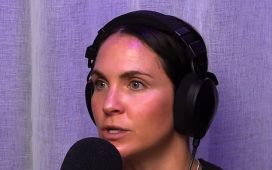They say you can’t have too much of a good thing, but the many corporations that produce television are out to prove that you can.
There’s just too much TV. There was too much in 2018 and 2017, too, and probably even before 2015, when FX chief John Landgraf, coined the term “Peak TV” to describe the then-400+ scripted TV shows on the air. This year, there are more than 500. And that doesn’t count reality shows, talk shows, documentaries and everything else.
Peak TV was supposed to represent the height of the TV industry, the point at which no more shows could possibly be created until a bubble burst and the number of series – and possibly networks that aired them – diminished wildly.
But that’s not at all what happened. The TV bubble hasn’t burst. It has inflated faster than you can binge-watch all 263 episodes of “Friends.”

This month has seen the debuts of Apple TV+ and Disney+, two streaming services from two of the biggest corporations on earth.
They’ve come to challenge behemoths Netflix and Amazon, and to lesser extent Hulu (which is majority owned by Disney), and to forge a future in an entertainment industry in which technology has completely upended the way audiences experience art. Or, to be as capitalism-focused as the streamers: an industry in which technology has completely overturned how consumers devour content. The near-future of TV promises an arms race to rival the money spent on the space race, as two more media companies, NBC Universal and WarnerMedia, join the fray next year with Peacock and HBO Max.
More: Disney+ to Apple TV+ to Netflix: All the major streaming services, ranked
There is too much TV now and there will be far too much TV in the future. I don’t know about you, but I am exhausted, even as a person who watches TV for a living. I look at the forthcoming revolution not with joy that my favorite media is about to take over the universe, but with fear and anxiety. The streaming wars are bad for TV fans and bad for the art form itself.
We’ve long since passed the point where anyone could keep up with most new and notable TV. How many people have seen any of the Emmy nominees for the outstanding drama this year, besides “Game of Thrones”? Can you even name one other show in that category? How many series have you meant to watch but haven’t gotten around to yet? When you log onto your preferred streamer, do you sample something new, or just navigate to repeats of “The Office” or “Seinfeld”?
Not to mention the old: Here are all the new Disney+ shows and movies, from ‘Mandalorian’ to ‘High School Musical’
More to come next spring: HBO Max: Details on launch date, price and programs, including 23 seasons of ‘South Park’
Apple enters showbiz: Here are all the new Apple TV+ shows and movies, from Oprah and Reese to Snoopy and Brie
Television is no longer easy entertainment delivered directly to our living rooms. Instead, it’s become one more thing we have to “keep up with.” Of course, no one is required to keep up with the avalanche of new TV shows (well, except TV critics), but so many shows enter the cultural conversation, it’s hard to say if you can find one that everyone at a dinner party or the proverbial office water cooler have all watched. And even if you have, the bingeing era means you might not be at the same place in the story. TV has lost much of the community aspect that made it so compelling. And the number of series to keep up with grows daily.
There are downsides to the flood of programming beyond the limited hours we can sit on our couches and watch. And at this pivotal moment in the history of television, I can’t help but think that it is headed down the worst possible path.
The upside of Peak TV, thus far, has been a (slight) diversification of the industry as Netflix, Hulu and Amazon (along with traditional cable and broadcast outlets) have embraced new storytellers. More women and people of color work behind (and in front of) the camera on television. LGBTQ stories are being told to mainstream audiences. Tiny shows from across the pond beat HBO’s best offerings at the Emmys. At the same time, TV’s prestige in culture began to rise. Our biggest movie stars no longer look down at the small screen, but embrace it as a new, exciting avenue for art.

Our current TV era has led to an abundance of specific and subversive series like Hulu’s “Shrill,” about a fat woman who is not obsessed with losing weight, or Netflix’s explicit teen comedy “Sex Education.” In the smaller TV world of 10 years ago, neither series would have found a home in the U.S., but now they fit in nicely on their respective streamers. There are dozens more examples of these small but mighty series, from Emmy-winning comedy “Fleabag” on Amazon to “The Good Wife” spinoff “The Good Fight” on CBS All Access to Donald Glover’s auteur experiment “Atlanta” on FX.
But as the competition for viewers becomes bigger, the ideas behind series are becoming perpetually smaller. Some of the networks and streaming services that made time and space for niche programming are moving away from it entirely. Netflix, once the proud savior of tiny, critically-acclaimed but canceled-too-soon TV series like “Arrested Development,” has been increasingly aggressive about ending their series after two or three seasons. It’s reached the point where the script has flipped, and it was obscure cable channel Pop that “rescued” a canceled Netflix series, fan-favorite “One Day at a Time.” Amazon, which burst onto the streaming scene with groundbreaking “Transparent,” is pivoting to blockbusters, putting huge piles of money into bringing “Lord of the Rings” to TV.

As the new streaming giants enter the fray, they are thus far not relying on exciting, experimental new talent or unique concepts, but greenlighting knockoffs of familiar titles they own without much discretion. “Star Wars,” Marvel superheroes, “High School Musical,” “Toy Story” and “Lizzie McGuire” are just a few brands Disney+ leans upon. Peacock has a “Real Housewives” spinoff and a “Battlestar Galactica” reboot. HBO Max will bring back everything it has a claim to, from “Gossip Girl” to “Grease.” Apple banks on big budgets and big stars, from Jennifer Aniston to Reese Witherspoon to Stephen Spielberg and M. Night Shyamalan.
As bigger, broader-appealing TV series continue to debut, what quieter series survive get even less attention than they would have before. In the rush to discuss the shockwaves that Apple and Disney brought this month, little attention has been paid to a more traditionally released program: Showtime’s incredibly poignant “Back to Life.” It is a sad British comedy about a woman (Daisy Haggard) who returns home to her British village after 18 years in prison. I could tell you about the gorgeous subtlety of “Life,” about Haggard’s exquisite performance, and how fans of existential British comedy such as “Fleabag” will find something to enjoy in its quiet contemplation of life. I could shout about it from the rooftops, but would anyone hear me over the blasters in “The Mandalorian”?

The first programs from Apple and Disney don’t provide much confidence for quality TV from mega-streamers in the future. The much ballyhooed “Mandalorian” is a disappointment, a “Star Wars” series that, at least in its first episode, lacks the depth of a “Star Wars” movie. Apple’s “The Morning Show” somehow wastes the talents of Witherspoon, Aniston and Steve Carrell. Each service (for now) has one good show – “High School Musical: The Musical: The Series” and “For All Mankind,” respectively – but neither has a single great show yet. Imagine if, as happened with Netflix, it takes dozens, if not hundreds, of mediocre or terrible series in order to find one that is transcendent?
What if Peak TV never actually reaches a peak, and the mountain of content launched on unsuspecting viewers – who couldn’t possibly watch it all if they quit their jobs and never slept – just keeps getting bigger? What if, paralyzed by indecision, viewers start watching TV the way many already consume the news: choosing only the “safe” shows that are familiar enough to confirm their existing world view, instead of taking a chance on something that could expand it the way the best art does?
The best television shows take risks, push boundaries and enlighten their viewers. Thousands of series like FX’s “Pose” can do very little if viewers only choose to watch the latest CGI remake of a 1950s-era cartoon.
It’s hard to get excited about the wide and open-ended future of TV. I look out at the vast virtual landscape of “The Mandalorian” and “The Morning Show” and I can only feel one thing: Truly, gut-wrenchingly tired. Welcome to the age of the Streaming Wars. I hope we survive.













